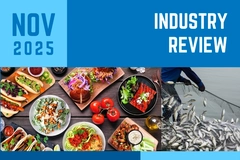
- Industry news
Industry news
- Category news
Category news
- Reports
- Key trends
- Multimedia
Multimedia
- Journal
- Events
- Suppliers
Suppliers
- Home
- Industry news
Industry news
- Category news
Category news
- Reports
- Key trends
- Multimedia
Multimedia
- Events
- Suppliers
Suppliers
Food technologists refine next-gen cohort of animal-free fats for advanced plant-based meat alternatives

22 Jul 2022 --- Pioneers of plant-based alternative fats are making significant strides in fine tuning solutions based on rice bran, soybean protein, algae and oleaginous yeasts. Industry’s newest iterations of animal fat substitutes aren’t only proving to be convincing mimics in terms of functionality, but are also deemed highly environmentally sustainable and scalable.
In recognition of the sustainability and technical challenges with current alternative fats, the Good Food Institute (GFI) has released a call for proposals on plant-based or fermentation-derived fats for use in meat alternatives.
From many proposals emerged five new grantees focused on alternative fats: Salma Mohamad Yusop, Naazneen Sofeo, Kyria Boundy-Mills, Jiakai Lu and Alejandro Marangoni.

While native plant lipids typically lack the functionalities of animal fats, the researchers uncovered that their molecular structures can be modified or separated to create solid fats more akin to their animal counterparts.
Alternatively, native plant lipids can be combined with other ingredients – like proteins, phospholipids, or carbohydrates – to form emulsion- or gel-based fat alternatives.
 Native plant lipids can be combined with other ingredients – like proteins, phospholipids, or carbohydrates – to form emulsion- or gel-based fat alternatives.Wonders of oleogelation
Native plant lipids can be combined with other ingredients – like proteins, phospholipids, or carbohydrates – to form emulsion- or gel-based fat alternatives.Wonders of oleogelation
GFI grantee San Martin, professor of engineering at University of California, Berkeley (US), creates plant-based oleogels for plant-based meat. Oleogelation is one of the most in-trend methods for reducing or replacing the unhealthy and controversial fats in food products.
To make an oleogel, a low concentration of gelator molecule is added to oil to make it more firm yet jellylike. With the appropriate processing (heating, stirring and cooling, for example), the molecules are dispersed in the oil and self-assemble to form 3D networks, jellifying the liquid oil.
Different edible oleogels are currently being formulated by various techniques and used in spreads, bakeries, confectioneries, and dairy and meat products.
There is a wide range of food-grade oleogelators – such as proteins, polysaccharides, small molecules like phytosterols, and waxes and other lipids – that can entrap oils without modifying their chemical traits. As a result, oil nutritional value is retained, and oil leakage during cooking is reduced.
Martin uses saponin emulsifiers and sunflower and canola oils to create his oleogels. Saponins are naturally occurring compounds that are widely distributed in all cells of legume plants. They derive their name from their ability to form stable, soaplike foams in aqueous solutions.
Martin particularly emphasizes that saponins are excellent emulsifiers, which ultimately prevents oil leaching during cooking when it acts as a gelator.
Christopher Gregson, CEO of Paragon Pure, which offers technologies that stem from sprouted brown rice, highlights that rice bran oil and rice bran wax are proving to be viable gelators. These are upcycled from an abundant byproduct of rice polishing (the conversion of whole grain rice to white rice).
“Rice bran oil and rice bran wax have very positive sustainability footprints, particularly given their ability to replace animal fats and tropical oils like palm, coconut and shea,” he notes.
To understand how his wax-based oleogels should function in meat, Dr. Gregson worked with Canadian researchers to pinpoint key microstructure and thermal properties as well as rheological and texture attributes of adipose tissue from conventional animal sources.
 Marine microalga Aurantiochytrium sp. SW1, native to Malaysia, can produce lipids up to 60% of the cell weight with 35-50% of the lipids being omega 3 fatty acid DHA.Oleaginous yeasts and microalgae
Marine microalga Aurantiochytrium sp. SW1, native to Malaysia, can produce lipids up to 60% of the cell weight with 35-50% of the lipids being omega 3 fatty acid DHA.Oleaginous yeasts and microalgae
Some microbes, like microalgae and oleaginous yeasts, have high-quality and high-quantity lipid content, which makes them attractive for alternative fat technology. Oleaginous yeasts, in particular, have high lipid content (up to 70% dry weight) and were previously optimized for petroleum replacements.
Meanwhile, marine microalga Aurantiochytrium sp. SW1, native to Malaysia, can produce lipids up to 60% of the cell weight with 35-50% of the lipids being omega 3 fatty acid DHA.
“[Oleaginous] yeasts are low in fat (below 20% dry weight) when they are actively growing. When the growth medium runs out of nitrogen, but carbon is still present, the yeasts continue eating the carbon source (sugar, alcohol, organic acid, etc.),” underscores professor Kyria Boundy-Mills, professor of food science and technology at the University of California.
“They convert it into oil – swelling to four to five times their former size, and filling with lipid storage bodies made of triacylglycerols (the same storage oil used by plants and animals). Some yeasts reach over 65% oil by dry weight.”
But because of carbon’s key role in enhancing oil concentration, carbon-rich feedstocks like glucose or other carbohydrates are applied to grow oleaginous yeasts.
A project at A*STAR, led by GFI grantee Dr. Naazneen Sofeo, is evolving oleaginous yeast strains to grow on cheaper sources than pure carbohydrates. Specifically, A*STAR is aiming to sustainably produce yeast lipid profiles similar to the triacylglycerols found in chicken and sheep fats.
Dr. Sofeo is using carbon-rich agri-industrial waste streams from cocoa processing in her work and described the environmental and cost benefits of this method.
Imitating beef adipose tissue
Animal fats have higher melting points than plant oils, providing a solid structure that slowly melts while cooked. Alternative fats should ideally melt similarly to animal fats.
 GFI grantee, professor Jiakai Lu, uses high internal phase emulsions of soybean protein and soybean oil to mimic beef adipose tissue.
GFI grantee, professor Jiakai Lu, uses high internal phase emulsions of soybean protein and soybean oil to mimic beef adipose tissue.
In addition, animal adipose tissues are composed of fatty cells in a collagen fiber network, making their structure challenging to replicate with other lipids. Alternative fats must have similar structures to reach taste and texture parity with animal fats.
GFI grantee, professor Jiakai Lu uses high internal phase emulsions of soybean protein and soybean oil to mimic beef adipose tissue.
“Our existing prototypes are much softer than real adipose tissue at low temperatures and do not melt when heated,” says Jiakai Lu, professor of Food Science at University of Massachusetts, Amherst (US).
“In this project, we therefore aim to optimize these [emulsions] so they can be fortified with plant-based omega 3 rich oils, be successfully incorporated into protein-rich muscle analogs, and exhibit the texture and melting properties exhibited by real adipose tissue.”
Microalgae for algal fats
GFI grantee Dr. Salma Mohamad Yusop and her team plan to harness fermentation technology to grow microalgae and optimize the production of its DHA-rich lipids.
The Yusop lab then plans to emulsify and structure the resulting algal oil with soy proteins and transglutaminase.
“Using a variety of methods to incorporate the algal oils into a network of plant fat crystals and crosslinked proteins, the functional properties of the resulting mixtures will be tested against animal fats as well as plant-based sources such as palm oil,” says Dr. Yusop.
The research team also plans to model costs for industrial-scale versions of this process.
By Benjamin Ferrer











